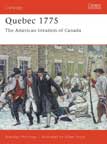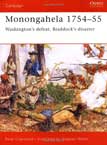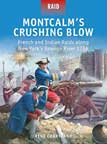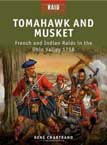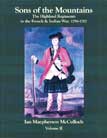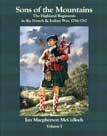

Osprey's examination of one of the key campaigns of the French and Indian War (1754-1763). On 9 July 1755 amid the wilderness of North America, Britain suffered one of the most humiliating defeats in her history. General Braddock’s army, a mixture of British regulars and American militia, was shattered, losing over 900 men from a force of 1,300. Braddock was killed and the remnants of his army rescued by his aide, Colonel George Washington. The origins of this defeat can be traced back to the death of a junior French officer little more than a year before in a relatively minor skirmish with a party of Virginian militia commanded by the same George Washington. René Chartrand examines the subsequent chain of events that ultimately sparked a world war.
With expert analysis and lively narrative, this engaging study of the Oswego raid casts light on a daring feat of arms at the height of the French and Indian War.
The year 1755 saw the rivalry between Britain and France in North America escalate along the Great Lakes into open warfare as both sides sought to overcome the other's forts and trading posts. Lord Loudoun and the Marquis de Montcalm were sent from the mother countries to take charge, but the French lost no time in seizing the initiative, adopting Canadian-style "wilderness" tactics and planning a series of raids to keep the enemy on their toes.
Amid the snows of March 1756, a 360-man French, Canadian, and Indian force stormed an Anglo-American outpost named Fort Bull in a surprise attack that left few survivors and the fort reduced to charred remains. Fort Bull's fall meant that the Mohawk River, the communication route between British-held Albany and the large and important Anglo-American post at Oswego, could now be cut off. Oswego, on the shore of Lake Ontario, had a formidable garrison based in three forts, named Pepperrell, George, and Ontario. The newly arrived Montcalm was tasked with the job of taking Oswego from the Anglo-Americans.
In July and August 1756, Montcalm's 3,000-strong force - including a full train of artillery, 80 pieces strong - was transported in hundreds of sailing ships and craft. The Anglo-Americans failed to spot the approaching French forces until they had landed and secured their positions. Having surrounded and invested the forts, the French soon knocked out of action a number of British guns. The British evacuated Fort Ontario and then, at 9am on August 14th, a French cannonball killed the British commander, Colonel James Mercer. His successor, Colonel John Littlehales, did not have the stuff of a hero; an hour later, the white flag went up and Oswego surrendered just in time to avert a major onslaught.
The Oswego raid was an outstanding French success; it denied the British a presence on Lake Ontario for the next two years, and relieved British pressure on Fort Frontenac. It demonstrated that the use of traditional European siege tactics in an American setting could reap great rewards, and had a great influence on the French's Indian allies too.
In 1758, at the height of the French and Indian War, British Brigadier General John Forbes led his army on a methodical advance against Fort Duquesene, French headquarters in the Ohio valley. As his army closed in upon the fort, he sent Major Grant of the 77th Highlanders and 850 men on a reconnaissance in force against the fort. The French, alerted to this move, launched their own counter-raid. 500 French and Canadians, backed by 500 Indian allies, ambushed the highlanders and sent them fleeing back to the main army. With the success of that operation, the French planned their own raid against the English encampment at Fort Ligonier less than fifty miles away. With only 600 men, against an enemy strength of 4,000, the French & Amerindians launched a daring night attack on the heart of the enemy encampment. This book tells the complete story of these ambitious raids and counter-raids, giving in-depth detail on the forces, terrain, and tactics.
Detailed essays on 18th-century uniforms, Highland weapons, specialist officers, and men (including pipers), as well as a comprehensive biographical index of all regimental officers (over 350 entries), who served in the three regiments--the 42nd (Black Watch), 77th (Montgomery's) and 78th (Fraser's) Highlanders--make this book the most complete and informative work on the history of the early Highland regiments of the British Army in North America during the French and Indian War to date.
Chronicles the stirring story of the three Highland regiments that soldiered in North America during the French and Indian War. The exploits of the 42nd (Black Watch), 77th (Montgomery's) and 78th (Fraser's) Highlanders, in some of the most bloody and desperate battles ever fought on the this continent, were a critical factor in transforming the overall image of Highlanders in the latter half of the 18th century from Jacobite rebels to Imperial heros.
St. Felix I ends his reign as Catholic Pope
French King Hugo Capet crowns his son Robert the compassionate King
Pontifical degree "Sancta Romania" against spiritualists
English King James I cracks Protestation of Parliament
"Messiah" Sjabtai Tswi departs to Constantinople
Abraham Crijnssen departs to Suriname
Baron Karl Rabenhaupt occupies Coevorden Neth
Don Francisco de Agurto installed as land guardian of S Netherlands
Henry Purcell and Tates opera "Dido and Aeneas, " premieres in Chesea
Tokyo hit by Earthquake; about 37,000 die
French troops conquer Grave Neth
Wearing masks at balls forbidden in Boston
Danzig surrenders to allied armies
1st coffee planted in Hawaii (Kona)
After gold discovery in Ga, Cherokees forced to move across Miss R
HMS Beagle / Charles Darwin sails from New Zealand to Sydney
Lehman-theater in St. Petersburg catches fire; 100s die
Opera "Stradella" after being rewritten is produced (Hamburg)
Pennsylvania Rock Oil Co, 1st in US, incorporated in New York City
US, banks stops payments in gold
Philadelphia Knights of Labor forms
American Metrological Society forms (NYC) weights, measures and money
Andrassy Note calls for Christian-Muslim religious freedoms
Belgium: King Leopold II installs Order of African Star
Dr Miles V Lynk, physician, publishes 1st Black medical journal
Russia signs military accord with France
Stanley Cup: Montreal Victorias beat Winnipeg Victorias, 6-5
Province of Zululand annexed to Natal colony
American Political Science Association founded at New Orleans
Iran becomes a constitutional monarchy
Stanley Cup: Mont Wanderers outscore Edmonton, 13-10 in 2 game set
Sun Yat-sen elected 1st President of the Republic of China
Barnes takes 17 wickets vs. South Africa (8-56 & 9-103)
Cromarty Harbour, Scot-British cruiser Natal explodes: 405 die
John E Hoover decides to be called J Edgar Hoover
Soviet Union organized as a federation of RSFSR, Ukrainian SSR, Belorussian SSR and Transcaucasian SSR
Edwin Hubble announces existence of other galactic systems
New South Wales score 705 against Victoria, go from 8-475 to 9-701
Chicago Tribune reports the Tigers threw a 4-game series to the White Sox in 1917 to help Chicago win the pennant (never substaniated)
Japan dedicates 1st subway in Orient (route under 2 miles long)
Sigma Gamma Rho Sorority incorporates
Government disallows NSB-membership for civil service
Italian bombers destroy Swedish Red Cross unit in Ethiopia
United Auto Workers stage 1st sit-down strike, at Fisher Body Plant
Electronic television system patented (V K Zworykin)
Nazibezetters oblige artsen member to become of Artsenkamer
Nazis require Dutch physicians to join Nazi organization
Winston Churchill addresses Canadian parliament
Phillies trade Babe Dahlgren to Pittsburgh for Babe Phelps and cash
King George II of Greece, abdicates his throne
36th Davis Cup: USA beats Australia in New York (4-1)
King Michael of Romania, forced by communists abdicates his throne
Romanian Republic proclaimed
"Kiss Me, Kate" opens at New Century Theater NYC for 1077 performances
Vietnam, Laos and Cambodia become Independent states in France Union
Tuskegee Institute reports 1952 as 1st yr in 71 with no lynchings in US
"House of Flowers" opens at Alvin Theater NYC for 165 performances
1st use of 24-sec shot clock in pro basketball (Rochester vs. Boston)
Harold Arlen / Truman Capotes musical premieres in New York City
New York Giants beat Chicago Bears 47-7 in NFL championship game
Israeli government of Ben-Gurion, resigns
New York Giants win NFL championship
George Washington, 1st ballistic missile sub commissioned
Green Bay Packers beat the New York Giants 16-7 in NFL championship game
Congress authorizes Kennedy half dollar
Green Bay Packers win NFL championship
Ferdinand Marcos inaugurated as President of the Phillipines
Great Western Forum opens in LA
Paul McCartney sues his bandmates to dissolve the Beatles
Long Island NHL franchise purchased (NY Islanders)
President Nixon halts bombing of North Vietnam and announces peace talks
1st picture of a comet from space (Comet Kohoutek-Skylab)
Miami Dolphins beat Oakland Raiders 27-10 in AFC championship game
Minnesota Vikings beat Dallas Cowboys 27-10 in NFC championship game
Beatles are legally disbanded (4 years after suit was brought)
"Boccaccio" closes at Edison Theater NYC after 7 performances
Constitution of Democratic Republic of Madagascar comes into force
Carter holds 1st news conference by US President in Eastern Europe (Warsaw)
"King & I" closes at Uris Theater NYC after 719 performances
Ohio State dismisses Woody Hayes as its football coach
Rock group, Emerson, Lake and Palmer break up
Togo adopts constitution
"Wonderful World of Disney, " last performance on NBC-TV
Wayne Gretzky sets NHL record of 50 goals by 39th game of season
Anthony Shaffers "Whodunnit, " premieres in New York City
US Assay Office in New York City, New York closes
Miss Elizabeth (Hulette) and Macho Man Randy Savage (Poffo) wed
IBM-PC DOS Version 3.2 released
Pakistan restores constitution
Australia hang on for draw vs. New Zealand at MCG, 1 wkt left 17 runs short
Premier Mugabe elected President of Zimbabwe
North subpoenas Reagan and Bush as defense witnesses for upcoming trial
10th United Negro College Fund raises $12,000,000
Dmitri Volkov swims world record 50m freestyle (27.15 seconds)
"Miser" closes at Circle in the Square Theater NYC after 93 performances
11th United Negro College Fund raises $10,000,000
Shane Warne takes 7-52 to lead Australian MCG win vs. West Indies
"Candles, Snow, and Mistletoe" closes at Palace NYC after 7 performances
Singer Deni Hines (22) weds INXS guitarist Kirk Pengilly (35)
Vatican recognizes Israel
Carquest Bowl 6: North Carolina beats Arkansas, 20-10
